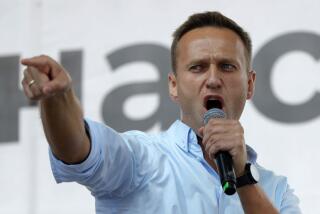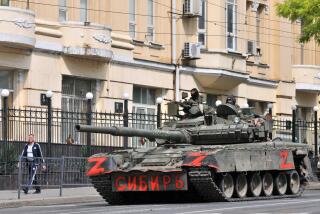Gorbachev’s Strengths, Weaknesses Show Up in Kremlin Roster Changes
- Share via
WASHINGTON — More than mere curiosity underlies the widespread American interest in what the latest reshuffling of the Kremlin leadership means. For the fate of the “revolutionary perestroika “ launched by Mikhail S. Gorbachev is important to the United States and to the world, as well as to the Soviet Union. While we still do not know all that led to the latest changes, nor all that they portend, the main lines are clear.
The leadership switches reflect Gorbachev’s strength and further consolidate his power. Gorbachev, now president, not only has a broader personal role, but also a more cohesive and supportive leadership group to help effect the revolutionary reform that he is attempting to impose on the Soviet Union and its policies.
Apart from the personnel changes--and in the long run perhaps as important--is Gorbachev’s determination to pare sharply the size and role of the party bureaucracy, in Moscow as well as in the country at large. The Central Committee apparat may be cut by as much as half--up to 3,000 people. The 22 “departments” of the Central Committee are being consolidated into six powerful “commissions.” And reductions are to be pressed elsewhere as well.
While the retirement of several older and less flexible members of the Politburo and the shift of several others to less central roles is an indicator of Gorbachev’s strength, the very fact that they had to be made, and in a hasty and preemptive manner, is at the same time an indication of the strength of the obstacles he faces. These include a skeptical and resistant element in the leadership--now reduced but not eliminated in the top echelon, still very strong in the Central Committee itself and the national and regional party and administrative bureaucracies. There is no overt opposition, but there is a great deal of merely nominal support accompanied by passive marching in place, foot-dragging and even masked sabotage of the implementation of programs that require very active, sustained drive if they are to have even a chance of success.
Well aware of this fact, and recently shaken by growing signs of widespread public malaise and dissatisfaction, as well as scarcely veiled attacks on some policies by his own second in command, Yegor K. Ligachev, Gorbachev concluded the time had come to strike quickly and take more of the reigns of power.
Some commentators have depicted the recent changes as though they marked a clean sweep of aging conservative deadwood and infusion of younger leaders from Gorbachev’s generation. That is only partly true. Ligachev, the most powerful potential alternative leader--and one who has clearly presented himself as a more conservative man with a more cautious reform agenda--has not, after all, been removed from the Politburo. The second leader closest to him in sentiment and stance, Viktor M. Chebrikov, also remains. So does Vladimir V. Shcherbitsky, the Ukrainian party chief of long high standing in Brezhnev’s “time of stagnation” (to use the current, and apt, derogatory description of the 20 years before Gorbachev).
Clearly, Gorbachev would have gained still more power and leeway if these three had also been retired from the Politburo (and in Ligachev’s case from the Secretariat), yet they remain and Chebrikov has even been added to the Secretariat. Either Gorbachev was unable to remove them or considered it more prudent not to attempt to do so.
Ligachev has, however, been removed from responsibility for ideology (and hence too from a wedge into foreign policy that he had recently used in an attempt to undercut Gorbachev’s close colleague Eduard A. Shevardnadze).
Ligachev’s successor and new Politburo member Vadim A. Medvedev has lost no time in strongly affirming the reformist ideological line on both domestic and foreign policy. In a speech to an international gathering of communist political theorists last Tuesday, he reconfirmed the Gorbachev line, challenged by Ligachev in August, explicitly giving priority to universal values such as peaceful coexistance over the pursuit of class struggle.
Chebrikov has been removed from control of the KGB, a potential threat to Gorbachev. Chebrikov has been replaced by Gen. Vladimir A. Kryuchkov, a long-time protege of the late Yuri V. Andropov, Gorbachev’s own sponsor, and not by a party leader beholden to Chebrikov.
Shcherbitsky, while conservative in his inclinations, has been careful not to get in Gorbachev’s way or challenge his programs; he has also kept the Ukraine calm as local nationalist sentiments have created a crisis between Armenia and Azerbaijan and launched a risky experiment in permitted nationalism in Estonia and Latvia.
Some have interpreted Ligachev’s new assignment in charge of agricultural affairs as a no-win situation for him, no-lose for Gorbachev. To the extent Ligachev succeeds, it can be taken as a success for Gorbachev’s perestroika and economic reform; to the extent he fails, the failure can rest on him. There is some truth in that assessment, but Gorbachev very much wants and needs to have the agricultural reform succeed. He cannot afford to let it fail, even if the blame could then be assigned to Ligachev.
The retirement of Andrei A. Gromyko, and lesser party leaders Mikhail S. Solomentsev, Pyotr N. Demichev and Vladimir I. Dolgikh removed elder conservatives from the Politburo and opened the way to promote several younger and more reform-minded associates of Gorbachev--Medvedev, Alexander V. Vlasov, Anatoly I. Lukyanov and Alexander P. Biryukova (the first woman in the Politburo since Khrushchev’s time).
Least clear to most American commentators has been the retirement of 68-year-old Anatoly F. Dobrynin from his position on the party Secretariat and head of the former International Department. The explanation may be as simple as the fact that there was no appropriate place for him after the merger of his department under Politburo member Alexander N. Yakovlev--and that his place on the Secretariat was needed for another party leader who would concentrate on urgent problems at home. His retirement probably has no policy significance and signals no change in Soviet policy toward the United States.
How then does the shake-up shape up? Gorbachev’s wide-ranging program of revolutionary change in Soviet society and policy is, not surprisingly, running into difficulties. Above all, people must see perestroika as something that raises their standard of living and of life, with a visible payoff in the near run. A feeling of relief and even enthusiasm greeted Gorbachev’s accession to power and early declarations of reform and renewal, but too little has changed in three years. Intellectuals are exhilarated by more free and open discussion and revision of history. But that does not affect the average person’s daily existence.
In some ways, daily lives of most people have become more difficult instead of better. Gorbachev and his supporters, plus the more conservative elements in the leadership and bureaucracy, have recently come to appreciate that fact. While the conservatives would have eased off on reforms, Gorbachev seeks to redouble efforts and press harder. He now has a somewhat freer hand to do so, but the difficulties remain daunting.
More to Read
Sign up for Essential California
The most important California stories and recommendations in your inbox every morning.
You may occasionally receive promotional content from the Los Angeles Times.













